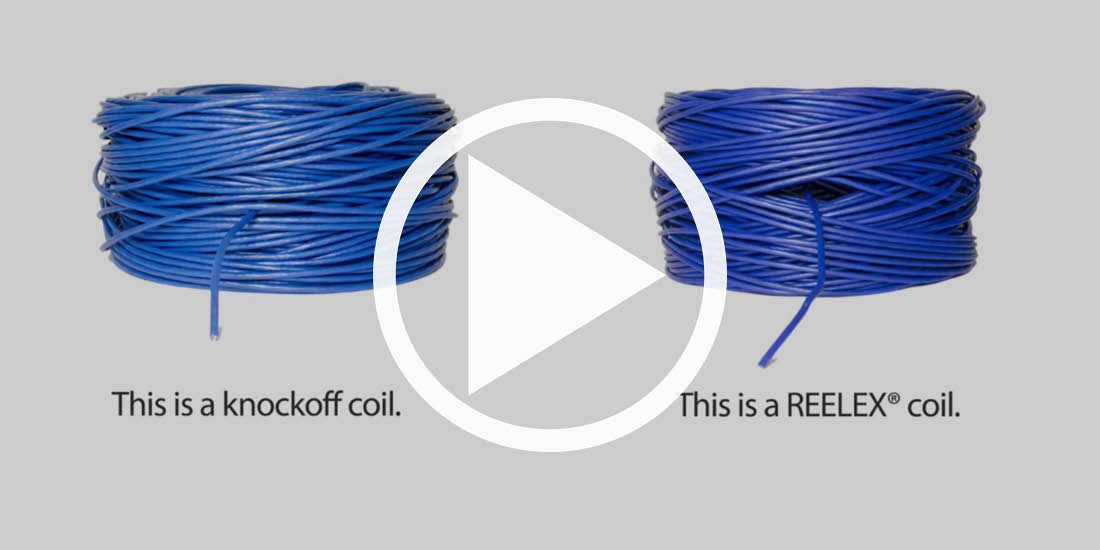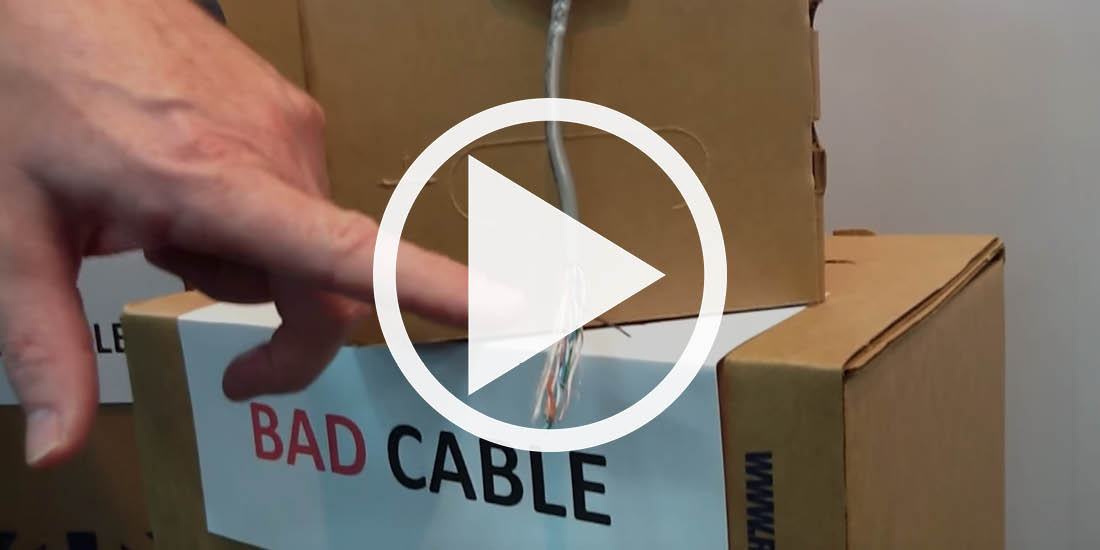What is an Imitation REELEX Package?
Imitation and Knockoff REELEX packages look the same from the outside, but inside are very different. Knockoff REELEX machines make knockoff packaging, and produce coils that can knot, tangle and cause cable damage.
The difference is in the coil…
REELEX
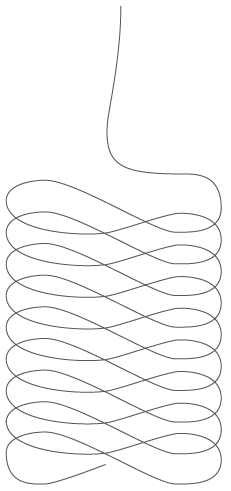
Imitation

Knockoffs mean knots
The key to the REELEX coil is unique machine programming which results in a perfectly formed figure-eight coil with a clear, controlled payout hole.
This payout hole separates each half of the figure-eight and must be properly placed to provide tangle and twist-free payout.
Knockoff REELEX machines do not make clear, precise payout holes in the coil like REELEX machines do.
This means that at some point during payout, a knot is likely to occur. This is because with imitation coils, there is high likelihood that at least one (or many more) loops in the figure-eight can be on the wrong side of the hole. The result is multiple loops and twists in a row, or worse: a knot.
…and in the machine
Knockoffs risk cable damage
REELEX equipment is specially designed to handle high-performance cables. Over nearly 50 years, we have developed and perfected components and processes to ensure cables are packaged with their integrity intact.
As the last component in the manufacturing process, the packaging machine is a critical component in the quality of a particular cable.
Knockoff coiling machines simply imitate without understanding the basis for what we do. Much of what makes REELEX unique is hidden, and key components must be designed with care or else risk cable damage. From programming to geometry to materials, everything REELEX manufacturers is done to ensure high-performance cables stay high-performance.
Why is it a problem?
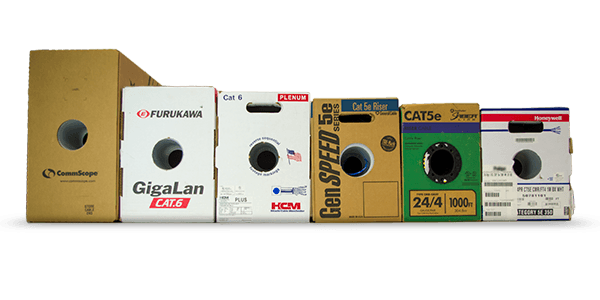

Good Cable vs Bad Cable
Imitation REELEX packaging is one of the first indicators of non-compliant or counterfeit cable
As is well-documented by the Communications Cable and Connectivity Association, and elsewhere in the wire and cable industry, non-compliant, low-quality and counterfeit cables pose a threat to safety, connectivity performance, and installer liability.
At REELEX, we are well aware of the issue, as most non-compliant and counterfeit cable are packaged using knockoff REELEX machines by manufacturers that are not licensees. These imitation packages pose a threat to REELEX, as they mimic REELEX packages, but perform far worse and can even cause damage to the cable.

REELEX is a proud member of the Communications Cable and Connectivity Association – a non-profit industry group dedicated to to inform, educate and provide thought leadership on vital issues and topics, including non-compliant and counterfeit cables.
What do I look for?
Learn to spot a REELEX knockoff
 From the outside, it can be very difficult to tell genuine REELEX from an imitation.
From the outside, it can be very difficult to tell genuine REELEX from an imitation.
The example at left shows a genuine REELEX II coil, and a knockoff coil with a “REELEX II” hole. In this case, the payout tube was actually forced into the coil to make it look like a REELEX II box. Needless to say, this package kinked and knotted almost immediately upon payout.
At right is a “typical” imitation package compared to a standard REELEX II box. Note the “scrambled” wind pattern and small payout tube.
Below are some warning signs that you may be using an imitation package and should think twice before trusting the cable.



1. No Clear Hole, “Scramble Wind”
Most knockoff REELEX machines are incapable of making a clear, precise payout hole in the coil. This means that at some point during payout, a knot is likely to occur. This is because with imitation coils, there is high likelihood that at least one (or many more) loops in the figure-eight can be on the wrong side of the hole.
The result is multiple loops and twists in a row, or worse: a knot. Knots often must require dismantling of the package in order to remedy, and often render the package unusable. Multiple twists in a row can cause product damage and tension to back up into the coil – leading to kinks and tangles.
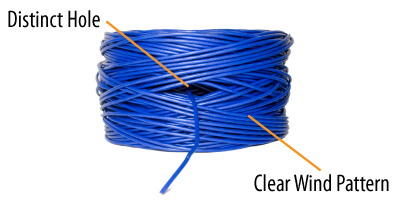
REELEX Coil
REELEX coils are precision-wound, and form a clear payout hole into the coil. This guarantees that every layer is a figure-eight, and thus twist-free. The payout hole also ensures the payout will be tangle and twist-free 100% through the coil.

Knockoff Coil
Knockoff coils have vague, forced or non-existent holes and are produced simply by having the traverse move faster than the spindle shaft. This essentially creates a “scramble wind“. The operator then forces a payout tube randomly into the coil. Not only is this coil not twist-free, but it is very likely to tangle or knot at some point during payout.
2. Are they using a small or oddly-shaped payout tube?
While many genuine REELEX licensees are using REELEX I for data cables, the majority have switched to REELEX II for its better payout performance, improved box design, and gentler handling of LAN cables. Knockoff REELEX machines cannot produce REELEX II coils, as the payout hole (if any at all) cannot be made big enough. Genuine REELEX equipment can make any size payout hole in the coil, allowing REELEX II to be used easily.
Note: some substandard cable manufacturers have attempted to make REELEX II coils by physically opening up the coil (either by hand or by tool) and forcing a larger payout tube into the hole. This can be catastrophic not only to payout performance, but also puts excessive pressure on the cable itself – leading to cable damage and performance issues.
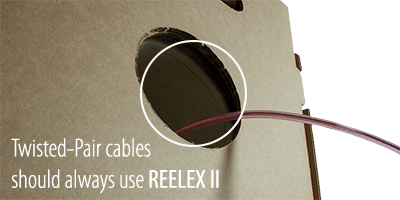
REELEX Coil
Most (but not all!) REELEX licensees have moved to REELEX II or EcoCore packaging for their structured cabling products. While not every manufacturer uses REELEX-branded payout tubes, any package using a payout tube larger than 1.50 to 2.00 inches in diameter (including EcoCore) is effectively using a REELEX II coil.
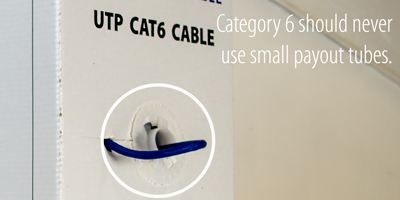
Imitation Coil
Imitation REELEX coils are incapable of making REELEX II coils. Thus, nearly all imitation coils are REELEX I knockoffs (small tube). That being said, some manufacturers have literally forced larger tubes into their coils, often rendering the packages unusable or causing significant damage to the cable.
3. An Unusually “Flat” Coil
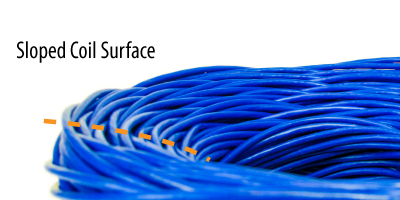
REELEX Coil
REELEX machines use precise, mathematically-derived geometry in constructing the mandrel and endform shapes. These shapes are vital in producing precision-wound coils at high speed. They also have effects on tension within the coil, which in turn must be managed in order to have minimal effects on LAN cable electrical properties.
Note: The new S290 coiling machine featuring the G2 Traverse produces coils that have extremely flat, dense structures. However, coils produced by this machine have clearly defined payout holes and are typically small-diameter products such as building wire or alarm cables.

Imitation Coil
Imitation coils often use incorrect geometry when coiling on knockoff machines. While we at REELEX understand geometry is vital to proper coil formation, non-REELEX machines will often use incorrect mandrels and endform shapes in order to fit the product into a specific box size. This incorrect geometry can cause payout issues as well as damage to LAN cables.



